Introduction
Here are some examples of exercises for you to try. The exercises may be suggested for a condition or for rehabilitation. Start each exercise slowly. Ease off the exercises if you start to have pain.
You will be told when to start these exercises and which ones will work best for you.
How to do the exercises
Big-toe flexor stretch
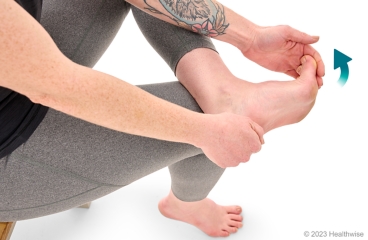
slide 1 of 6
slide 1 of 6, Big-toe flexor stretch,
- Sit in a chair, and put your affected foot across your other knee.
- Grasp your heel with one hand and then slowly pull your big toe back with your other hand. Pull your toe back toward your ankle until you feel a stretch along the bottom of your foot.
- Hold the stretch for 15 to 30 seconds.
- Repeat 2 to 4 times.
- It's a good idea to repeat these steps with your other foot.
Big-toe extensor stretch
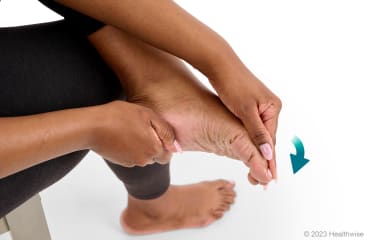
slide 2 of 6
slide 2 of 6, Big-toe extensor stretch,
- Sit in a chair, and put your affected foot across your other knee.
- Grasp your heel with one hand and then slowly push your big toe down with your other hand. Push your toe down and away from your ankle until you feel a stretch along the top of your foot.
- Hold the stretch for 15 to 30 seconds.
- Repeat 2 to 4 times.
- It's a good idea to repeat these steps with your other foot.
Big-toe traction stretch
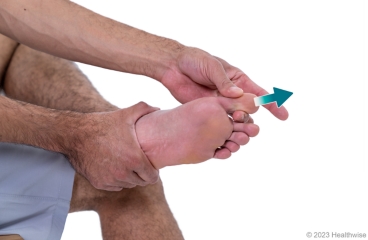
slide 3 of 6
slide 3 of 6, Big-toe traction stretch,
- Sit in a chair, and put your affected foot across your other knee.
- Grasp your heel and the middle part of your foot with one hand. With your other hand, use your thumb and middle finger to grasp your big toe and gently pull it straight out and away from your foot.
- Hold the stretch for 15 to 30 seconds.
- Repeat 2 to 4 times.
- It's a good idea to repeat these steps with your other foot.
Forefoot stretch
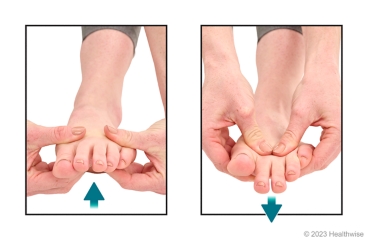
slide 4 of 6
slide 4 of 6, Forefoot stretch,
- Sit in a chair with your affected leg bent, and put the heel of your affected foot on the edge of the seat. Or you can sit on the floor with your leg bent and your heel resting on the floor.
- Grasp your foot with both hands. Your thumbs will be on the top side of your foot just below the joints where your toes connect to your foot. Your other fingers will be underneath your foot.
- Use the fingers underneath your foot to push up on the two toes that are closest to your big toe. Then use your thumbs and hands to spread your foot and toes outward until you feel a stretch in your foot. The outer edges of your foot will curve downward as you push up on the middle toes. Hold the stretch for 15 to 30 seconds.
- Next, slowly press your thumbs down on the two toes that are closest to your big toe. The outer edges of your foot will curve upward. Hold the stretch for 15 to 30 seconds until you feel a stretch in your foot.
- Repeat 2 to 4 times.
- It's a good idea to repeat these steps with your other foot.
Towel scrunch

slide 5 of 6
slide 5 of 6, Towel scrunch,
- Sit in a chair, and place your affected foot on a towel on a hard floor (not a floor with carpet).
- Scrunch the towel toward you with your toes. Then use your toes to push the towel back into place.
- Repeat 8 to 12 times.
- It's a good idea to repeat these steps with your other foot.
Make this exercise more challenging by placing a weighted object, such as a soup can, on the other end of the towel.
Marble pickups
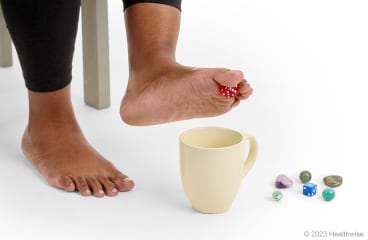
slide 6 of 6
slide 6 of 6, Marble pickups,
- Put some marbles, dice, or small smooth rocks on the floor next to a cup.
- Sit in a chair, and use the toes of your affected foot to lift up one item from the floor. Then try to put the item in the cup.
- Repeat 8 to 12 times.
- It's a good idea to repeat these steps with your other foot.
Current as of: July 24, 2025
Author: Ignite Healthwise, LLC Staff
Clinical Review Board
All Ignite Healthwise, LLC education is reviewed by a team that includes physicians, nurses, advanced practitioners, registered dieticians, and other healthcare professionals.

